|
|
|
|
| DataGlove model 4 | TouchGlove | Cyberglove | Dexterous Handmaster | Powerglove | Anaphase | 5th Dimension |
| Space glove | GLAD-IN-ART | Motion Orch. Systems | Cyberfinger | PinchGlove | SUPERGLOVE |
|
|
|
|
| DataGlove model 4 | TouchGlove | Cyberglove | Dexterous Handmaster | Powerglove | Anaphase | 5th Dimension |
| Space glove | GLAD-IN-ART | Motion Orch. Systems | Cyberfinger | PinchGlove | SUPERGLOVE |
1
·
Greenleaf Medical Systems
VPL Research inc.: DataGlove model 4
Date: 9 nov 93.
Description: uses fiberoptic sensors DOF: 5 metacarpo-phalangeal joints, interphalangeal joint of the thumb, 4 proximal interphalangeal joints of the other fingers Range: flexion and hyperextension Angular resolution: < 1 deg over entire dynamic range (12 bit a/d) Static accuracy: < 5 deg over entire range Data acquisition rate: upto 160 Hz Data communications interface: RS232 from 1K2 to 115K2 Operating conditions: 15-40 deg C at rel. humidity of 30 to 60 %, non condensing Size: 17"x7"x17" (control unit, 19" rack mountable), three sizes / left and right handed (glove) Power: <100 W Price: US$ 11,700.- (Dataglove model 4 control unit + glove + software), US$ 2.700,- (additional glove).Reference: VPL Dataglove model 4 product information. VPL Dataglove model 2 manual. Wise et al (1990), Eglowstein (1990), Hong et al (1989), Lasko-Harvill et al (1988), Zimmerman et al (1987).
Comments:The Dataglove (originally developed by VPL Research) is a neoprene fabric glove with two fiber optic loops on each finger. Each loop is dedicated to one knuckle and this can be a problem. If a user has extra large or small hands, the loops will not correspond very well to the actual knuckle position and the user will not be able to produce very accurate gestures. At one end of each loop is an LED and at the other end is a photosensor. The fiber optic cable has small cuts along its length. When the user bends a finger, light escapes from the fiber optic cable through these cuts. The amount of light reaching the photosensor is measured and converted into a measure of how much the finger is bent (Aukstakalnis and Blatner 1992). The Dataglove requires recalibration for each user (Hsu). "The implications for longer term use of devices such as the Dataglove--fatigue effects, recalibration during a session--remain to be explored" (Wilson and Conway 1991).
Greenleaf Medical Systems
DataGlove. A digital glove with movement analysis software (MAS) for data collection of wrist and hand motion. DataGlove collects data dynamically in 3D space through digital sensors, which track the wearer's movement, fitted on a lycra glove.
Designed for medical applications of VR and can be used as an input device for functional assessment, stroke-injury rehabilitation, ergonomics, and sports medicine. Price: contact vendor.
Greenleaf Medical Systems, 2248 Park Blvd., Palo Alto, Calif, 94306, (415) 321-6135, fax (415) 321-0419.
VPL Research Inc.
DataGlove Model 4 System. Patented input device converts hand gestures and positions into computer-readable form. The system consists of a DataGlove, a desktop control unit (that supports up to four DataGloves). Interfaces to host computers via RS-232 serial communications, Software for SGI, Macintosh, and IBM. Optional Polhemus 3Space Isotrak 11, Fastrack, or other tracking systems, Price: contact vendor.
Advanced DataGlove Unix Programmer System Toolkit. Source code license for noncommercial use. Lets users interface the Data Glove system to UNIX applications through high-level commands to a C-language linkable library. Provides users with gesture-recognition and editing capabilities. Consists of an optimized linkable library and executable server. Price: contact vendor.
VPL Research Inc., 3977 E. Bay Shore Rd., Palo Alto, Calif. 94303, (415) 988-2550, fax (415) 988-2557.
2 · Infusion Systems: TouchGlove
Date: May 1998. Description: force sensitive sensors mounted inside glove at finger tips and palm Price: $199 US
3 · Virtual Technologies (Virtex): Cyberglove

Date: 21 june 91.
Description: uses piezoresistive sensors DOF: 3 flex sensors + abduction sensor per finger, plus thumb crossover, palm arch, wrist flexion and abduction Angular resolution: 0.5 degrees over entire dynamic range Material: 80/20 nylon/lycra Interface: RS232, up to 115K2 Sampling rate: 100 Hz Price: US$ 9,800.- (18 chan.)Reference: Product information Virtex Cyberglove. Personal communication.
Features:
CyberGlove® is a low-profile, lightweight glove with flexible sensors which accurately and repeatably measure the position and movement of the fingers and wrist. CyberGlove's award-winning design incorporates the latest high-precision joint-sensing technology. CyberGlove is state-of-the-art in instrumented gloves.
The CyberGlove is available in two models and for either hand. The 18-sensor model features two bend sensors on each finger, four abduction sensors, plus sensors measuring thumb crossover, palm arch, wrist flexion and wrist abduction.
The 22-sensor model adds sensors to measure the flexion of the distal joints on the four fingers.Patented Sensor Technology
The CyberGlove features Virtual Technologies' patented resistive bend-sensing technology that is linear and robust. The sensors are extremely thin and flexible and produce almost undetectable resistance to bending. Since the sensors exhibit low sensitivity to their positioning over finger joints and to the joints' radii of curvature, each CyberGlove provides high quality measurements for a wide range of hand sizes, and ensures repeatability between uses. Calibrations typically need not be updated, even after months of use.
Designed for Comfort and Functionality
The CyberGlove is constructed with stretch fabric for comfort and a mesh palm for ventilation. The 18-sensor CyberGlove includes open fingertips, which allow the user to type, write and grasp objects while wearing the glove. CyberGloves are available for both hands.
The CyberGlove System
The basic CyberGlove system includes one CyberGlove, its instrumentation unit, a serial cable to connect to your host computer, and an executable version of our VirtualHand graphic hand model display and calibration software. Many applications require measurement of the position and orientation of the forearm in space. To accomplish this, mounting provisions for Polhemus and Ascension 6 DOF (degrees of freedom) tracking sensors are available for the glove wristband. Tracking sensors are not included in the basic CyberGlove system, but are available as an option from Virtual Technologies and are supported in the VirtualHand® software. The CyberGlove has a software programmable switch and LED on the wristband to permit the system software developer to provide the CyberGlove wearer with additional input/output capability. The instrumentation unit provides a variety of convenient functions and features including time-stamp, CyberGlove status, external sampling synchronization and analog sensor outputs.
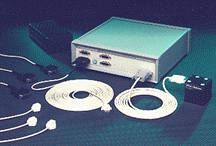
ApplicationsThe CyberGlove is an ideal body-sensing glove for:
virtual reality, telerobotics, task training, medicine, CAD, sign language recognition, video games, graphical character animation, music generation, hand-function analysis
Specifications
Sensor Linearity: 0.62% maximum nonlinearity over full range of hand motion.
Sensor Resolution: 0.5 degrees; remains constant over the entire range of joint motion.
Repeatability Between Glove Uses: Standard deviation of typically 1 degree.
Off-Axis Bending: Sensors respond primarily to bend about the single desired sensor axis.
Interface: RS-232 with selectable baud rates up to 115.2 kbaud. Analog output also provided.
Update Rate: Up to 112 records/sec when filtered (18 sensor records). Up to 149 records/sec when unfiltered. Preset sample period or polled I/O. (Higher rates possible when fewer sensors are enabled).
Physical Characteristics
Item Dimensions Weight CyberGlove One size fits most 3.0 oz Instrumentation Unit 10.00" x 6.25" x 2.75" 27.0 oz Power Supply (USA) 4.36" x 3.10" x 2.28" 2.5 lb Power Supply (Europe) 6.30" x 3.82" x 2.66" 3.5 lb Virtual Technologies products
CyberForce. Provides computer-programmable grip-force feedback to the CyberGlove user. Use the CyberForce system to detect, contact, and "feel" the compliance of telemanipulated objects. Price: contact vendor.
CyberGlove. An 18-sensor instrumented glove with 0.5* resolution, two bend sensors and one abduction sensor per finger, and sensors to measure thumb and pinkie rotation and wrist pitch and yaw. Twenty-two-sensor model adds third bend sensor for each finger. Comes with VirtualHand display software. Price: contact vendor.
CyberWear. A product line of body-instrument garments, including CyberArm, CyberVest, and full-body CyberSuit. CyberWear measures body motions, creating a moveable body image of more than head and hands. Price: contact vendor.
GestureGlove. Provides easy recognition of more than 30 different dynamic hand formations of a CyberGlove user. Neural network recognition software learns any hand formation and lets users select the text output for each hand formation. Price: contact vendor.
CyberCAD. A virtual CAD environment that lets users create, edit, and manipulate 3D virtual objects in a virtual room. Pull on object faces or stretch vertices and edges, rotate objects, magnify or group objects, change colors, or even cut holes. Price: contact vendor.
VirtualHand. Software calibrates the CyberGlove and displays a graphic representation of hand and finger motions on a computer screen. Price: contact vendor.
Virtual Technologies, 2175 Park Blvd., Palo Alto, Calif. 94306, (415) 321-4900, fax (415) 321-4912,
4 · Exos Inc.: Dexterous Handmaster
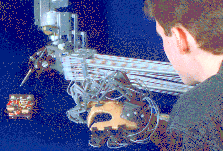
Date: 17 july 91 Description: uses Hall-effect sensors on exoskeleton DOF: 20 (glove) Sampling rate: upto 100 Hz Accuracy: ca. 1/2 deg. Interface: RS422 (for sampling rate 100 Hz), or RS 232 Software: for IBM compatible, VME, Apple Mac with at least 640 KB memory Weight: ca. 11 oz Temperature range: 25 +/- 10 deg C Price: US$ 17,400.-(includes complete PC).
Reference: Product information Exos Dexterous Handmaster. Eberman et al (1993), Marcus and Sturman (1991), Marcus and Eberman (1991 - 2 refs), Eglowstein (1990), Marcus et al (1989).
Comments:
The dexterous hand master (DHM) is not exactly a glove but a exoskeleton that attaches to the fingers with velcro straps. A mechanical sensor measures the flexion of the finger. Unlike the Dataglove and Powerglove, the DHM is able to detect and measure the side-to-side movement of a finger. The other gloves only measure finger flexion. The DHM is more accurate than either of the gloves and less sensitive to the user's hand size, but can be awkward to work with (Hsu).
The Dexterous HandMaster(DHM) was originally developed as a master controller for the Utah/MIT Dexterous Hand robot hand by Arthur D. Little and Sarcos. Since then it has been redesigned and is nowsold by Exos. DHM is an exoskeleton-like device worn on the fingers and hand. Using Hall-effect sensors as potentiometers at the joints it accurately measures the bending of the three joints of each finger as well as abduction of the fingers and complex motion of the thumb. The DHM measures 20 degrees of freedom of the hand---four for each finger and four for the thumb. The analog signals from the joint sensors are collected by a PC-compatible custom A/D board at up to 200 samples per second. Based on informal observation, the accuracy of the device is well within 1 degree of flexion. The DHM does not measure palm position or orientation, but a 3-space tracker can be attached for that purpose. Although originally developed for robotics, the DHM has been successfully marketed as a tool for clinical analysis of hand function and impairment. Its highly accurate sensors make it an excellent tool for fine work or clinical analysis. The DHM is a little cumbersome to put on and take off and requires some adjustment to fit the hand properly. Although light-weight, it has more mass than gloves and is less stable on the hand when the whole hand is shaken or moved rapidly. It is not an interface device suited for casual use. However, Exos has simplified and improved the technology, and it is available for measuring in-dividual fingers and other body joints.
5 · Mattel / Nintendo: Powerglove

Description: uses piezoresistive flex sensors + acoustic tracking for hand Distribution: Abrams-Gentile Entertainment (AGE) Inc. or Toys R us, K-Mart, etc. (toy stores) - may be sold out Interface: only works with Nintendo/Mattel products; third party interfaces available (e.g. AGE and Transfinite interface for Mac) DOF: 8, i.e. flexion of thumb, index, middle and ring finger + x, y, z, roll of hand Range: finger flexion only (i.e. no extension), hand position from 10 to 15 ft translation and handorientation +/- 45 deg working angle off the centre aids Resolution: 2 bit (low-res mode) or 8 bit (hi-res mode) for finger flexion, 1/24 % for hand roll and 6.35 mm for translation (distance of glove to receivers = 0.3048 m).
Reference: Mattel / Nintendo Powerglove manual, Eglowstein (1990), Gardner (1989), Mulder (1994).
Comments:
The Powerglove was originally sold by Mattel for the Nintendo Home Entertainment System but, due to its low price, has been used widely in research (Aukstakalnis and Blatner 1992). This Powerglove is less accurate than the Dataglove, and also needs recalibration for each user, but is more rugged than the Dataglove. The Powerglove uses strain gauges to measure the flexion of each finger. A small strip of mylar plastic is coated with an electrically conductive ink and placed along the length of each finger. When the fingers are kept straight, a small electrical current passing through the ink remains stable. When a finger is bent, the computer can measure the change in the ink's electrical resistance (Aukstakalnis and Blatner 1992).
Inspired by the success of the VPL DataGlove, the Mattel toy company manufactured in 1989 a low-cost glove as a controller for Nintendo home vidco games. The Power Glove is a flexible molded plasticgauntlet with a Lycra palm. Embedded in the plastic on the backs of the fingers are resistive-ink flex sensors that register overall bending of the thumb and index, middle, and ring fingers with two bits of precision per finger. (This is a limitation of the A/D converters used, not the sensors themselves.) Mounted on the back of the hand are acoustic trackers that locate the glove accurately in space (to one-fourth inch) with respect to a companion unit mounted on the television monitor. The trackers also provide four bits of roll orientation for the hand (rotation of the wrist). Although the least accurate of the whole-hand input devices the Power Glove is also the cheapest by a factor of 100. It works with several Nintendo games, such as one where punching motions control the swing of an on-screen boxer. Some games have been especiallv designed for the Power Glove. One allows a player to "hit" or "grab and throw" a ball against tiles in a hand-ball-like court imaged on the screen.
Unfortunately, after a two- or three-year run, Mattel stopped making the Power Glove, and now they are available only from stock or seeond-hand. The glove's low cost prompted many researchers to refit them for VR and glove-input systems. A general-purpose computer interface is not officially available for the Power Glove, but some people have reverse engineered the electronics necessary for connecting the Power Glove to a computer's serial port. One of the Usenet news groups, Sci.virtual-worlds, is a good source for this information. (See also a 1990 Byte article which has good descriptions and comparisons of the DataGlove, the DHM, and the Power Glove.") The Power Glove is not particularly comfortable or accurate, but it serviceably provides a crude measure of hand position and shape.
6 · Anaphase unlimited: (unkown product name)
Date: April 1995; Description: instrumented glove for VR applications; DOF: ?; Reference: Wired nr?? 95; Price: < 100 US$.
7 · 5DT (5th Dimension Technologies): Dataglove and flexor kit
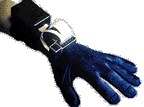
Date: April 1995; Description: instrumented glove for finger flexion and extension measurement, and flexor strip for elbow or knee flexion measurement. Comes with software development kit for DOS and Windows, Kinemusica software for virtual musical instrument creation and gesture recognition software; DOF: 5 ?; Accuracy: 8 bit; Sample rate: 25 Hz (all 5 fingers); Latency: ca. 8 ms; Data communications: PC ISA bus card allows 4 data gloves and 16 flexor strips to be daisy chained; Price: US$ 495.- (incl. shipping).
Reference: Roehl (1995).
Features:
Affordable quality, extreme comfort, open architecture, mouse emulation mode, right/Left hand versions, VR program drivers, 8-bit flexure resolution, one size fits many, built-in tilt sensor, high update rate, bundled software, low drift
Specifications:
RS 232 serial port interface (19.2 Kbaud)
8-bit resolution for each finger
One sensor (fiber optic) per finger
9V DC, 200 mA, power supply
Full hand (5 fingers, roll angle, pitch angle) may be sampled at 200Hz
Built-in 2-axis tilt sensor with ±60 degree useable range
Software:
KineMusica body instrument software (virtual piano, trumpet, horn and drum set)
Mouse emulator
Windows (3.X, 95, NT) API libraries and sample C/C++ code
16 and 32 bit DOS drivers with sample programs
Sample C/C++ code for generic driver development
Diagnostics and glove demo program
VR program drivers (WTK for Win, MindRender, Amber, Superscape, XVS-SyncLink, VRCreator)
Comments:
The 5th Glove DataGlove was designed as a 3D input device. It is suitable for a wide variety of applications such as: control and manipulation of virtual worlds, gesture and cognitive media, physiotherapy rehabilitation, control device for actors in tele-robotics...etc. The angle sensors have an 8 bit resolution, (256 angular values) per joint. Each sensor is read by a 12 bit A/D converter and delivers a value throughout the range of 0 to 255 according to the joint's bending (from open to closed position). The glove can be calibrated for the individual user. The 5th Glove's platform independence is provided by a RS-232 interface to suit any standard serial port. The maximal update rate per finger is 200 Hz.
8 · W Industries / Virtuality Entertainment Systems: Space glove
Description: uses fiberoptics DOF: one flex for each finger, two flex for thumb, 3-space magnetic tracker on the back of the hand. Resolution: 12 bit A/D used Material: soft-molded plastic Interface: only works with products of the same company.
Reference: Sturman et al (1994).
Comments:
W Industries, recently renamed Virtuality Entertainment Systems, based in Bristol, England, makes virtual reality arcade games. In 1991 the company released the Space Glove for use with their Virtuality system. The glove is made of soft molded plastic that fits over the back of the hand. Rings around the fingers and a strap around the wrist hold the glove in place. One flex angle for each finger and two flex angles for the thumb are measured using sensors with 12-bit A/D converters. A 3-space magnetic tracker is incorporated into the back of the glove.
Personal experience in using the glove for a short time found it fairly responsive to finger bending and hand movement, but somewhat uncomfortable, as the plastic has little give and constricts the fingers. The stiffness of the plastic also makes it hard to get the rings over the finger joints when putting on or taking off the glove. The Space Glove only works with W. Industries products.
9 · AITek s.r.l.: GLAD-IN-ART glove
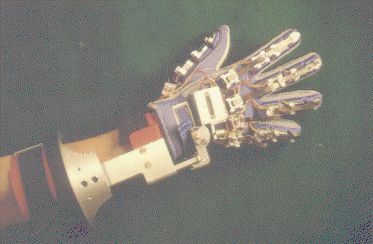
Date: 3 Oct 90 Description: uses piezoresistive sensors ? + force-feedback with exoskeleton Comments: The dataglove structure wraps around the hand and supports kinesthetic sensors for the fingers. Flexion-extension and abduction-adduction movements are recorded by the sensors. The glove has 12 motors, one for each phalanx of each finger (i.e. 3 per finger) with the little finger excluded. The glove contains 23 sensors. Each finger has 3 strain gauge sensors and one magnetic sensor. Two mechanical sensors and one made of conductive plastic monitor the wrist joint. The final force feedback glove will use only strain gages for force and conductive plastic for all fingers and other points of measurement. AITek is the leader of a european consortium funded by ESPRIT II. projectnumber is P5363. Price: no product available.
Reference: ESPRIT II P5363 GLAD-IN-ART proposal information. Personal communication.
10 · Motion Orchestration Systems: suit and glove
Date: 4 oct 93 Description: uses electromagnetic coil pairs of which relative position and orientation can be determined Interference: yes, but adding freq's easy Sensor: 3/4" square, 1/4" high coils, shifts around a bit, can be 6 DOF, but only one DOF is used Interface: wireless RF, own comm. protocol Update rate: 32 Hz Resolution: < 0.5 deg. Latency: < 62.5 ms. Suit-host connection: Pulsed Digital Modulation (PDM) serial transmission via 15 ft coaxial cord or wireless 300 MHz / 100 ft Host: IBM PC digital I/O card + quickC software DOF: 2 on each shoulder, 1 on each elbow, 1 on each forearm for torsion, 1 on each knee, 2 for ventral side of pelvis (dutch: "lies"), 1 on stomach, 1 on neck (totals 14 analog 12 bit), plus an additional 16 digital (8 for each hand to make contact at thumb or chest) Components: two part suit (spandex bottom + stretch leotard top), two stretch fabric gloves, belt with electronics, FM transmitter and receiver modules, additional cables etc. Calibration: via 5 different choreographed positions Comments: future extensions include optical wireless, more sensors (70 channels), more driving freq's, glove Price: aiming at US$ 1,000.- or less for a production model (not available yet).
Reference: Weber (1992), Personal communication.
11 · NTT Human Interface Lab: Cyberfinger glove
Date: 15 Nov 93 Description: uses 2 EMG registration sensors on wrist + neural network Accuracy: 20 deg on average Price: no product available.
Reference: For Cyberfingers, it's all in the wrist action Neural Chip Removes Need For Data Glove, The Nikkei Weekly, SCIENCE & TECHNOLOGY, (November 15 1993) p 13.
12 · Fakespace: PINCH Gloves
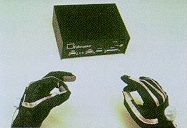
Gesture Space:
- Contact among any two or more digits (i.e. left forefinger to right forefinger).
- The gloves detect when two or more digits come in contact. After the contact is verified, it is sent to the host. The elapsed time between gestures is also recorded.
- Requires no calibration
Communications:
- Simple RS-232 protocol communicates gesture information and delta time stamps
- Dip-Switch selectable baud rates including 9600 and 19200
- Sample source code is available for either SGI or PC platforms
Power:
- 120VAC 11W to 9W wall transformer, 2.1mm plug
- FCC Class A device
Tracking:
The glove does not provide information pertaining to its location in space. A mount compatible with both the Ascension and Polhemus electromagnetic trackers is provided. Custom tracker mounts are also available.
13 · Nissho Electronic Corp.: SUPERGLOVE
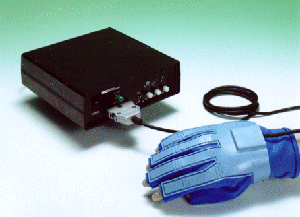
[PRODUCT INFORMATION]
In 1987, when VPL Research released the 1st DataGlove, Nissho Electronics became their exclusive distributor and technical partner in Japan. Since then, Nissho Electronics has significantly improved and developed the DataGlove concept, leading to the manufacture of the SuperGlove, in May 1995.[SPECIFICATION]
* Number of flex sensors : 10 (standard)
* Glove type : right hand / left hand (specified when order)
* Interface : RS-232C (1,200 - 34.8Kbps)
* Data format : ASCII, Binary
* Sampling rate : 200 microsecond / sensor
[PRICE in Japan]
Standard configuration \480,000.-
Additional glove only \200,000.-
Wireless option contact us
[ADDITIONAL INFORMATION]
SuperGlove employs new form of bend sensor (patent pending) instead of fiber-optics sensor. This bend sensor reads pressure generated by bending finger as slight electric-power. This sensor is brand new one made in Japan, co-developped between Nissho and its technical partner, one of manufactures of high-tech electrical devices in Japan. Because of this bend sensor, SuperGlove has following advantages, comparing to old VPL DataGlove:
High-accuracy : 0.3 degree
Reliable operation
Low cost; currently its list price in Japan is \480,000.-, and we are going to make it cheaper. By mass-production of bend-sensor, it is possible.
Customize; We can customize SuperGlove depending on customer*s requiremenets. Such as small glove for children, color glove for women, abduction sensor, sensors for wrist and elbow.
Wireless option; For some application such as motion capture, wireless operation is required. We have made a wireless version of SuperGlove, and shipped it already.
Embedded calibration capability: Old glove requires each person to calibrate it by software every time he or she wear it. So operator should repeat it, and sometimes a programmer should write a code for calibration. SuperGlove makes this procedure much easier, by embedding calibration capability inside a hardware (control unit). Operator just push 3 buttons to calibrate it. For similar size of hand, they may not necessarily do it.
[SOFTWARE DRIVERS]
We are planning to provide driver software of SuperGlove for Superscape VRT and World Tool Kit. We will also provide a driver software for UNIX (SGI IRIX).
| Last update: June 18th, 1999 |